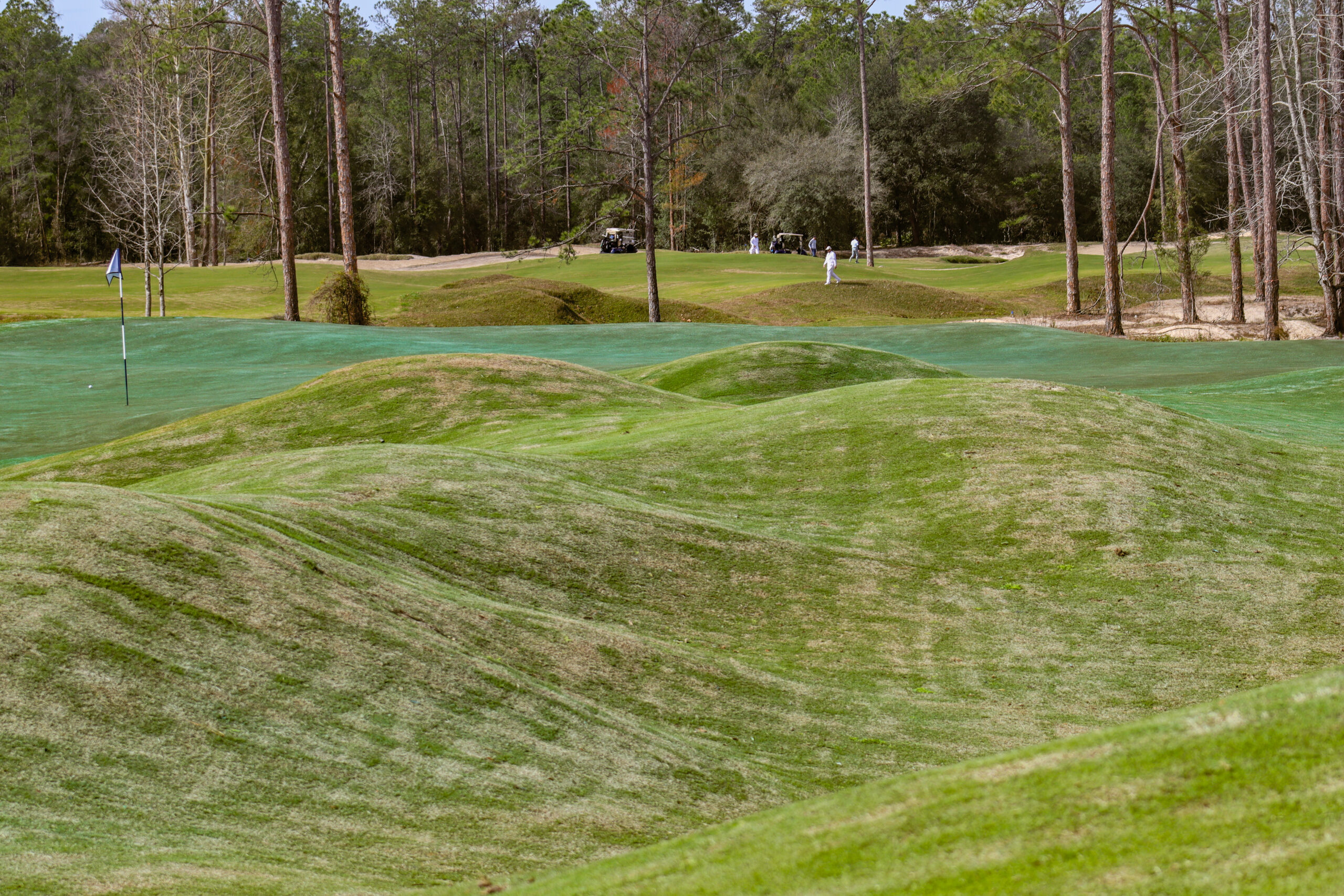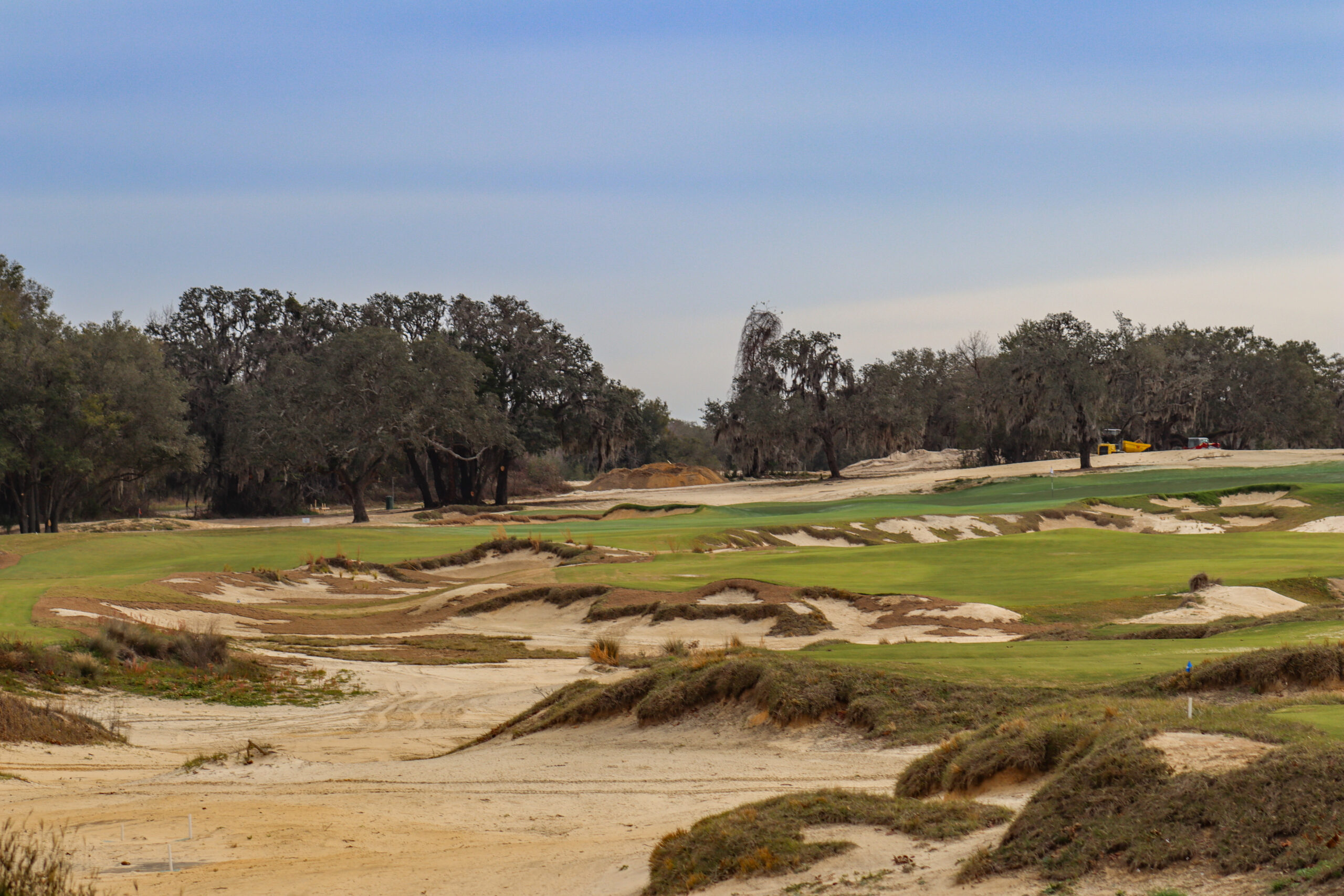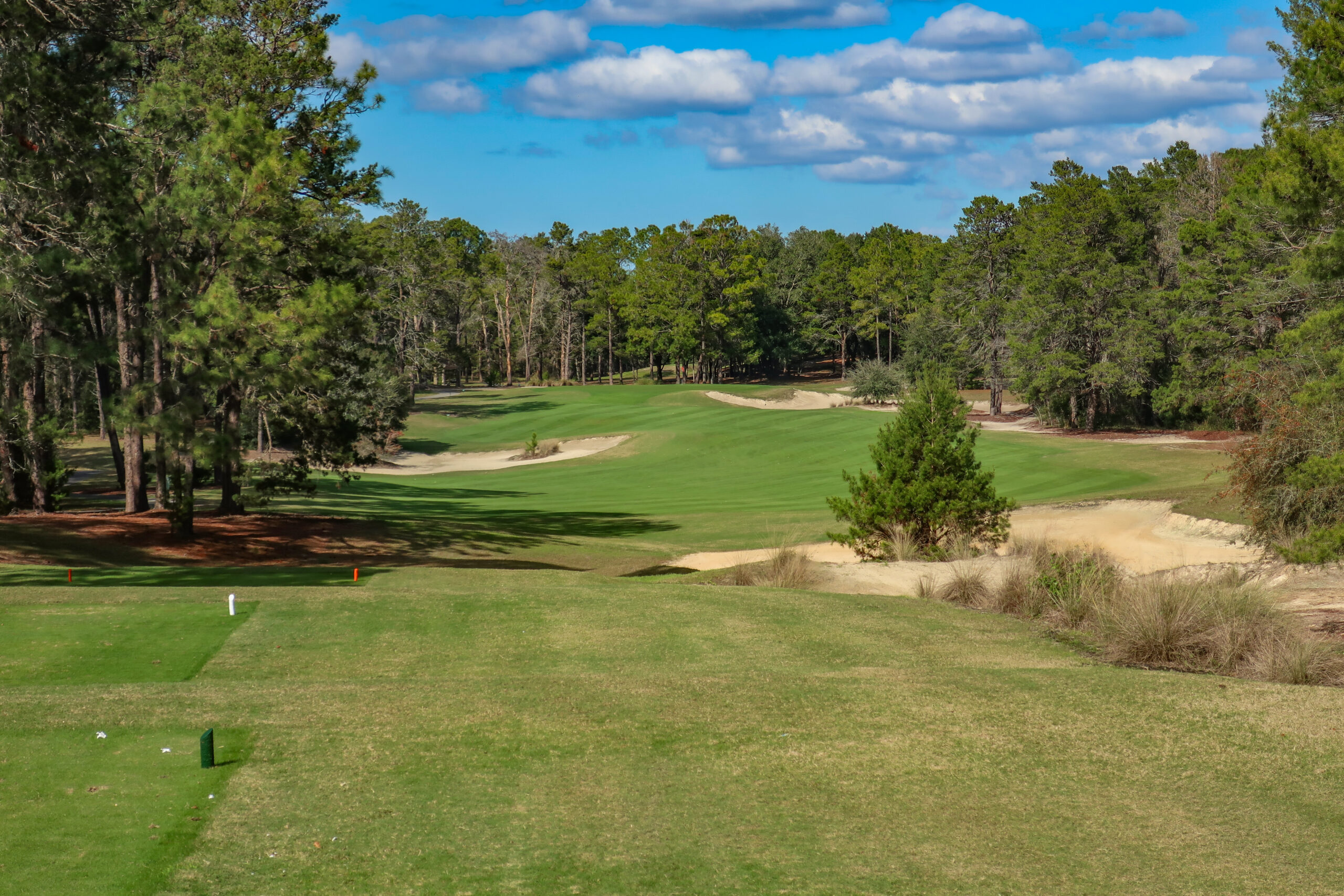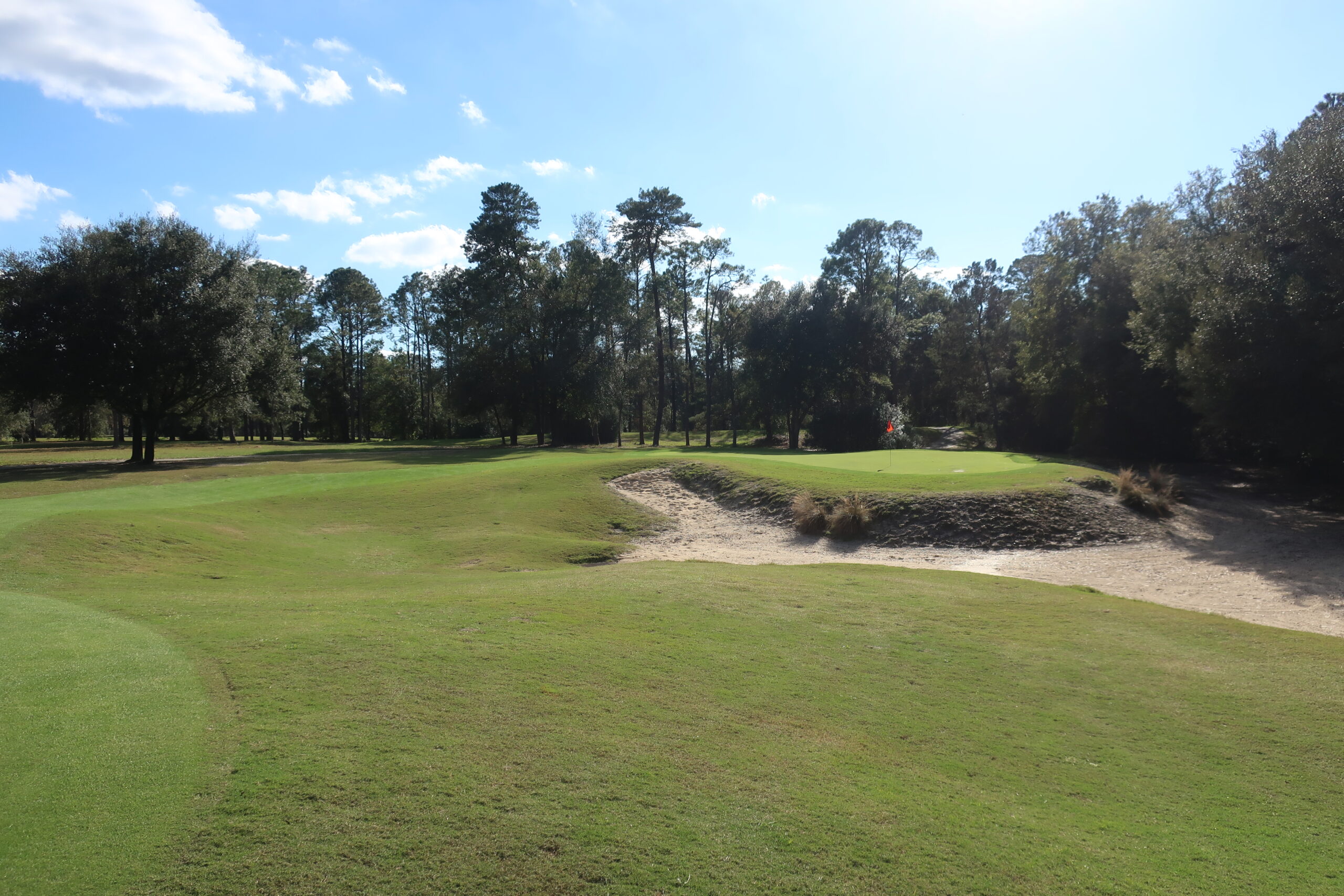The Karoo does what all golf courses should do, first and foremost: that is, it makes you want to play it again immediately upon holing the last putt
As I chronicled here, when the finer details of the Cabot Collection’s Brooksville, Florida venture were first revealed, I was quite skeptical about their planned reimagining of the Pine Barrens course. My skepticism had nothing to do with my confidence in the company’s ability to execute such a bold undertaking; rather, I felt like a father about to waive his eldest child away to college. Although I recognized that for its betterment something thorough had to happen to my beloved golf course—to my baby—I was still fearful to see what it would look like when it returned to the limelight—under its new moniker now, The Karoo. In my view, the original Pine Barrens, especially, which I’d played upwards of fifty times, merely needed some TLC. Truth be told, I didn’t really care about what they did to Rolling Oaks, which I enjoyed plentily but didn’t love nearly as forcefully.

A few days ago I was lucky enough to have been among the first to play the Karoo, and fighting my superficiality, my shallowness, I did my very best to come at it with an open mind, without hope or bias or arrogance, as untanklike as I could be, sans canon and machine gun and steel plating, as unmenacingly and as lightly as possible on my own ten toes instead of tearing up the turf with my caterpillar threads. Just as with most people, we get most golf courses wrong before we play them, while we’re anticipating playing them, while we’re playing them, after we’ve played them; then we go home, tell people we’ve played them, think longer about them, and probably continue to get them wrong. Only after round upon round, revealed in different circumstances, approached from different perspectives, laid bare under different light, does its true character, its true nature rise to the fore from beneath the frail, onion-skin like layers of prejudice and favoritism that wither away.
That said, I quickly recognized that I had gotten it largely wrong yet again and, therefore, I believe that Kyle Franz’s project can be considered a success, although I am still digesting its elements. All in all, I can say, with confidence too, that the standout features of Fazio’s original Pine Barrens have been enhanced and that the majority of Kyle Franz’s bold decisions—most notably reversing the playing corridors of the 2nd and 17th, and the 3rd and 16th, in order to eliminate the crossovers that were present in Fazio’s clunky routing—paid off. The 2nd – which bears an ethos similar to the 2nd at Pinehurst #2 with its few abutting fairway bunkers that pinch in at different points and angled green largely hidden beyond a perky set of mounds – and the long par 3, 3rd—which with good reason has been the ongoing focus of much of Cabot’s promotional campaign for Citrus Farms—are two of the definite new standouts of the golf course. The 3rd, in particular, is now surely among the finest, or at least most dramatic, one-shot holes in America, although it’s not my favorite of the set.

Make no mistake, there is alot going on out there—and sometimes too much, of that there is no doubt. After all, following his trio of successes in the Pinehurst area, among others, this was Franz’s big coming-out party, his first blockbuster movie for a big studio; and, as is human nature in such situations, it does seem as if he tried too hard in spots, that he overcooked it slightly, rather than just take or accept what he was given to work with. The most striking example is perhaps the heavy-handed shaping short and right of the green at the up-and-over par 4, 13th. Simply retaining the last fifty yards or so leading to the canted green complex in its previously lay-of-the-land manner would have yielded a better result, I think, for it was—and still is, despite this—one of the stronger par 4s on the golf course, which is replete with at least a half-dozen of such high quality. And the same goes for the strange double-green at which the 1st and 6th holes culminate, another element that just seems unnecessary really. Or the twenty-inch deep thump-print lacerating the front-middle of the 16th green complex.


Yet as I’ve pondered it more, I can also understand why the leadership team opted for such bold shaping and features. As a necessary byproduct of Cabot’s modus operandi as a multi-national resort conglomerate that, merely within the state of Florida, now has to compete with Streamsong, Bay Hill, Orlando, Naples, Doral, and TPC Sawgrass (along with whatever else is coming down the pipeline) for clients, they simply needed a golf course that would immediately capture the golfer’s attention upon initial play and, as importantly, in print and on social media, too. In film terms again, the golf course, especially with it being the first here, had to grip the audience with hair-raising action sequences and soundtracked mountages rather than through quiet dialogue and character development. Unlike when building a golf course geared primarily towards private and thus repeat play, Cabot and Franz and co. simply did not have the luxury of building something that would only begin to really reveal itself after a handful of plays. The reality is that most of their clientele will only play it once or twice on their first visit; and for those who do return to the golf overpopulated Sunshine State afterwards, if the golf course does not grip them, then they will simply go and spend their money elsewhere. Once Citrus Farms is better established, then, perhaps, they can build something more subtle, something more subdued, as Sand Valley and Bandon Dunes both did with their 3rd golf courses.
On the whole, Franz did pretty much everything that I would’ve have wanted in a more traditional “renovation” of the Pine Barrens (whatever the term “renovation” now means). In particular, the bunker work, which had lost its luster over time, is once again eye-catching, and it has been emphasized even further by the extensive tree removal which has re-introduced the long-views across the property that had been choked away by years and decades of overgrowth. Thanks to this uncluttering, a number of truly astonishing vistas are afforded—such as from the 4th tee-box or from the back of the 14th green—where one sees in every direction layer upon layer of sand either jutting into green sides or gnawing away at the edges of fairways in shark-bite-esque gashes. I worried, as with too many of the golf courses built or renovated recently, that the restoration would dissolve the distinct sense of place that was so strong and attractive about Pine Barrens, but thankfully it hasn’t. If anything, it has augmented it. The Karoo still feels like its own, unique golf course; and not one that could be transplanted seamlessly to Pinehurst or to Sand Valley.

Aside from my earlier quip about the double green at the 1st and 6th, the work on the handful of holes (the 1st to the 3rd; the 8th to the 11th; and the 17th and 18th) routed across the more macro-sloping and heavily pine-treed segment of the property, away from the ridge-lined and sand-scaped portion through which middle holes of both nines play, is exceptional and the most significant upgrade on what was there before. As with all great opening holes, the 1st hints at what is to come and also gives you the itch to see the rest of the course. Whereas Fazio’s version was punctuated by a single bunker in play to the left of the landing area, Franz broadened the saddle-shaped fairway and introduced to it a series of centerline bunkers, thus forcing a decision to be made right out of the gate.


In fact, thought-provoking center-line hazards that either make the golfer go right or left or over them, or otherwise entirely split the fairway in two or three distinct parcels, is the primary trope that Franz employed throughout his reimagining of the golf course from tee-to-green. The 1st, 4th, 5th, 8th, 11th, 14th, 15th, and 18th all feature a prominent central feature of some sort—of course, a number of these were present on Fazio’s iteration of the course, but even these have mostly all been moved, reshaped, and/or cleaned up to good effect. I tend to love center-line features so I had no problem with his liberal use of them, but I could understand if someone claimed that Franz slightly overdid it in this regard.
Although the 1st green is guarded by two fronting hazards, the 2nd and 3rd green complexes are both tightly guarded by hazards to their left but feature generous, and I mean generous, pads of rumpled and humped and hollowed fairway to their right, welcoming you, begging you in fact, to direct sweeping or low-running shots into their putting surfaces, especially until the turf matures and becomes a little more receptive. This is another common trope: green sites with one amply inviting side and one side on which you better not miss! Here, in addition to the two aforementioned ones, I’m thinking of the 7th, 8th, 10th, 11th, 14th, 16th, and 18th.


Returning to the use of central fairway hazards, the only new one that I found slightly out of place, perhaps, is the sand-covered hump that was added to middle of the fairway on the uphill 8th, which, in my mind, already featured plenty enough interest thanks to its angled and partially obscured landing area and the flanking waste-area protecting the inside of it. Moreover, I’m a little confused about why they made the grade of the far-right section of the lion-mouth shaped green so severe that, to my naked eye at least, it is unpinnable now— surely, you’d want this portion of the wonderful green available for a hole location, no?


This green, however, comes sandwiched between the two highly positive modifications that Franz made to the 7th, which is said to be modeled after the sideways biarritz at North Berwick, and to the 9th, which has been lowered and re-angled so as to be more receptive to a variety of shots than it had been previously. The 7th, which measures about 210 yards from the back tees but plays shorter, is the most thrilling and engaging of the par 3s in my eyes, since when the pin is cut anywhere on the right half of the seventy-ish yard wide, although extremely thin and perched surface, there seems no reasonable way for any golfer below PGA tour-skill level to get it close other than by using the kicker-sloped contour to feed the ball rightward through the sunken middle portion and up to the other side. This is a hole on which you could stand with a bucket of balls and spend hours hitting a whole plethora of shots.
The other hole that matches the 7th in terms of pure fun factor is the driveable, split-fairwayed, go-for-broke 15th. As with the similarly perplexing, option-filled par 5, 4th, Franz recognized a good thing here and didn’t mess with it a ton, it seems, other than reshaping green complex somewhat and cleaning up the trees to the left and the shrubbery that had overgrown in the waste area that defines their strategy from the tee. In fact, thanks to their exposure in Golf Digest and other print press at the time, these were the holes that very much put World Woods on the map originally, in the early 1990s. And they’re both still among the best of their kind.
In closing, is the Karoo perfect? No, but no golf course is, not even Cypress Point or St. Andrews. Will it be everyone’s cup of tea? No. Is it fair to wonder what a more experienced hand, such as that of a Tom Doak or a Rod Whitman, would have done here, if given the job? I think that that this is a fair and natural consideration, although I applaud Cabot’s bravery to go outside of the Doak/Coore and Crenshaw/Hanse comfort zone. But now that I’ve had an extra day to let it simmer in my thoughts, above all the Karoo does what all golf courses should do, first and foremost: that is, it makes you want to play it again immediately upon holing the last putt. It is a consistently riveting and engaging golf course, on which you’re not going to lose a ton of balls, on which you’re going to stand over a number of hitherto unfaced shots that can either turn out really well or really poorly often seemingly at random, and on which those elements that made me, and so many others, return again and again and again to Pine Barrens are still present, albeit a little more strikingly and boldly than before.









